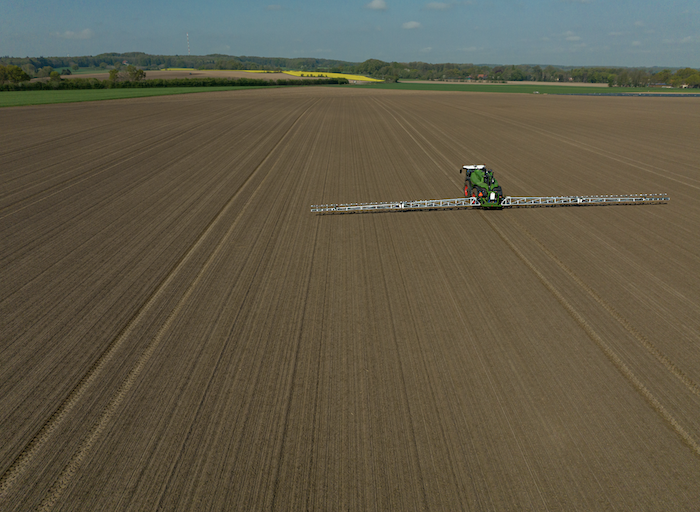AGCO and Bosch BASF Smart Farming recently announced they will work together to integrate and commercialize Smart Spraying technology on Fendt Rogator sprayers, and develop additional, new features.
“This collaboration will change the way growers apply product to their crops,” says Joe Dimler, AGCO application product specialist. “AGCO has the best chassis in the marketplace with a dual height machine, and now we’re bringing forward a solution from Bosch BASF that includes the latest and greatest technology in the world to spot and spray weeds on the go.”
Precision Farming Dealer contributing editor Dan Crummett catches up with AGCO application product specialist Joe Dimler for a deep-dive into the significance of the collaboration, how the smart spraying system works and when growers and dealers can expect to see it on the market.
Watch the VIDEO REPLAY of this podcast.
The Precision Farming Dealer podcast series is brought to you by Ag Express.
Ag Express provides services and support for a wide variety of electronic and electro/mechanical devices. We can offer component level repair of an individual customers unit, or, remanufacture and rework hundreds of units for an OEM or an Electronic Manufacturer. From though hole technology to high population fine pitch surface mount, from simple units to complex industrial units.
Ag Express is 100% employee-owned and celebrating over 30 years of "Providing Possibilities!"
Full Transcript
Hey, thanks for being here for another edition of the Precision Farming Dealer Podcast, brought to you by Ag Express Electronics. My name is Noah Newman, and today contributing editor, Dan Crummett goes one-on-one with AGCO application product specialist, Joe Dimler for a deep dive into the significance of their collaboration with BASF Smart Farming, how their smart spraying system works, and when growers and dealers can expect to see it on the market. Here's Dan.
Dan Crummett:Hello, Dan Crummett here, contributing editor for Farm Equipment and no-till Farmer Magazine. I'm visiting with AGCO representative, Joe Dimler about recent announcements that AGCO and Bosch BASF Smart Farming are collaborating on some exciting new developments for Fendt RoGator sprayers. Joe, would you introduce yourself and tell us what you do for AGCO and we'll talk about RoGator?
Joe Dimler:Yeah, absolutely. So I work in the Future Crop Solutions group that we have now established at AGCO, and my background is working in application and working with both RoGator and TerraGator products, and recently have brought the RoGator into the Fendt lineup.
Dan Crummett:Tell us what's in the future for RoGator. What does this agreement of collaboration between AGCO and Bosch BASF, what does that bring to the table?
Joe Dimler:Yeah, so what it brings to the table is the ability to bring a ton versatility to the way that we apply product today to our crops. So we're bringing forward a solution with AGCO where we feel like we have the very best chassis now in the marketplace with a dual height machine to the marketplace, and then bringing forward a solution from Bosch BASF with some of the very latest and greatest technology in the world to spot weeds and spray them on the fly on the go.
Dan Crummett:Well, tell me a little bit, I guess without getting into the blueprints, tell me a little bit about the hardware we're talking about here. What's going to be different?
Joe Dimler:Yeah, so what you'll see is, you'll see a dual tank, dual plumbing system, and you'll have a boom that's equipped with lights that are equipped on both sides of the camera, and it will be placed out in advance of the boom to be out looking to make those decisions on the fly whether to fire each nozzle that kind of covers that space or that zone as we apply throughout the field.
Dan Crummett:Is this all visible light we're talking about?
Joe Dimler:That's correct. So we have our lighting units, we'll have two lighting units, or we call it an FLU or a fluorescent lighting unit on each side of our camera, and that really gives us the ability to apply no matter what time of day it is or even apply into the evening or throughout the night.
Dan Crummett:Does that works in bright sunlight also? I mean the lights are on even in the daytime?
Joe Dimler:It does. The lights strobe at a certain speed, and so every time you see that light strobe, the cameras are actually taking a picture of what's going on in the field and making that split decision on whether or not it needs to fire that nozzle or not. So it's pretty impressive when it's running out in the field.
Dan Crummett:The nozzles are fixed or are they [inaudible 00:03:53] or something like that?
Joe Dimler:Nope, they're fixed nozzles. So yes. Yep. Our line that we will be broadcasting with, the strategy will be to broadcast with one tank and have that broadcast line 100% of the time in some of the applications, and then spot spray, if you will, with a PWM solution on the other line. And so what we've seen from that is that's been the best way to get us the best efficacy. There are single tank solutions out there, there's retrofittable options out in the marketplace, but the solution we really focused on was trying to bring forward, still allowing our customers to use liquid logic, which gives us a recirculating boom, air boom cleaned out, and the ability to rinse both tanks to meet the need all the way from a grower mixing a lot of different products all the way to an agri retailer that's making numerous products switches throughout the season.
Dan Crummett:Yes. On the split second designs for on the go spraying or capability, not designs, but that I take it as an artificial intelligence component. Can you tell us a little bit about how it was trained, what's been the development of that capability?
Joe Dimler:Yeah, absolutely. So the system has been trained by repetition, so it uses its logic based off of all of the imagery that it has seen and collected in the past, and so we're talking about millions and millions of images that it has the ability to use as a reference. Every time it sees a new image, it's going to go back to its model that was based off of all of these millions of images. And so as you go, you basically create a database that allows you to basically have seen just about every little type of scenario that you may see in each field because you've ran the machine that much and you have that many images to go back to look and compare against.
Dan Crummett:And I take it, this was developed with Bosch? Was this developed in Europe?
Joe Dimler:Yes. The project has been ongoing a little bit further or began sooner on our product to RG 600, our European sprayer. They have a little bit more experience at this time with the solution and some of that, Dan, is because of the green deal that Europe is talking about. By 2030, we're looking at this technology helping agriculture meet some of those standards that Europe is going to place for all of Europe, and so the technology is a little bit more advanced at this time for Europe, but quickly catching up here in North America,
Dan Crummett:You mentioned the recirculation capabilities on the RoGator. Go through that a little bit and tell us how the flow of active ingredient versus water, how that works on the upcoming product.
Joe Dimler:Yeah, yeah, absolutely. Yeah, so both lines, both tanks will have a recirculating plumbing and we believe that to be a huge savings in a reduction of risk for growers. What it allows us to do is send product out to the boom, remove all of the air in our plumbing so that when that split decision gets made on whether to apply, that we have the proper pressure already set to go, and we're fully primed and we're not fighting any air bubbles, we're reducing any risk on misfiring due to a plumbing issue.
But the nice thing about it is for product recovery or for rinsing, you're just going to reduce so much risk for contamination. We've had the product in the field now for about five years, and you literally can use it to add your detergent or your soap to the tank and send that detergent and soap water throughout the entire system, and so it makes it really, really nice. You have a lot of confidence that your system is clean when you're switching products or you're spraying from corn to soybeans or soybeans back to corn, that's made it really nice. The other thing too-
Dan Crummett:The tank is containing ingredient then it's a tank mix and so forth. It's not water in the tank being injected later?
Joe Dimler:No. Nope, nope. The way that we have the system built, it's a good question, Dan. So the way that we have it built is the grower would load his more residual product into the first tank, and we expect that product to pick up a little bit of some performance gains because it's actually going to be applied and the way that it was meant to, some of the things that we've seen from the industry are that our carrier volumes have continued to get higher and higher, and that's been because we've seen that need for the contact herbicides that we've used to control weeds, but that carrier volume really doesn't need to be that high for some of our more residual products. And so a part of the strategy is that we'll be able to separate out the chemistries so that we can apply at a certain rate out of one tank and then go ahead and really focus in on those contact herbicides that no one really wants to apply anyways.
You think of dicamba and 2,4-D and all the claims that we have today and the potential for a mishap with a volatile product like those products are. We're going to try and limit those products as much as possible and get that product really, really targeted on the weed and take away that full broadcast effect of having to apply all that extra product as we apply. But yeah, the grower would fill both tanks up with product and keeping those products separate. We see an advantage to not having this antagonistic effect of necessarily always having anywhere from three to six different active ingredients in the tank all at the same time. We know from talking with growers, there's definitely some instances with products that definitely like to conflict or bind when they're combined. Some of your volunteer corn product killers are an example of that, and then some of our other targeted herbicides that we have by any time you throw dicamba into the mix, you can start to lose some of that efficacy.
Noah Newman:Let's burn a quick time out. Here's a message from our sponsor, Ag Express electronics. Dealers, farmers and those in Ag know the importance of getting the most from their efforts. Technology has been a significant game changer when it works, when it doesn't, turn to the experts at Ag Express Electronics who find a way by specializing in the timely repair support sales and engineering of Ag technology. Ag Express provides component level repairs to save time and money on costly replacements. They also offer wiring harnesses and custom solutions to meet your customer's unique needs. A vast portfolio of over 2000 supported products allows Ag Express to provide possibilities for numerous agricultural concepts. You can feel confident doing business with Ag Express Electronics because of their excellent reputation, track record for quality work and commitment to technology. The company is 100% certified employee owned and celebrating over 30 years of providing possibilities. Now, back to the conversation.
Dan Crummett:The RoGator platform itself now, are we operating with a fixed height boom on this? Is that part of the design also?
Joe Dimler:The design of the boom will be similar to what we have today, so we'll offer the solution on both our standard clearance RoGator and our high clearance RoGator, but the positioning of the boom and the boom height control will be very similar to our standard offer, what we offer today.
Dan Crummett:Okay. The "new additions" to this then would be in the camera system, the light gathering in artificial intelligence component.
Joe Dimler:Yes, the lights, the cameras, and then the section control module that makes that real-time decision are the three additional components to the system that really make this targeted spray solution work.
Dan Crummett:You mentioned section control. How smart is each section and what are we talking about in number of nozzles?
Joe Dimler:Yeah, so we're building the solution to be versatile. So we have the capability to control all the way down to individual nozzle control. There's instances though where that's not necessarily in the best interest of the technology, so we're going to build in some versatility into the system and customization for that operator to be able to turn on the amount of nozzles that he feels comfortable with to do the job.
Dan Crummett:Okay. Tell me a little bit about how am operator would use this. It's sunrise, it's time to go, the winds down, time to spray. Just walk me through the spraying operation from filling to application and clean out, just to how this would work.
Joe Dimler:Yeah, so the first step is going to be using the xarvio app. It's an app or FMIS that's been created by Bosch BASF to create the job or create the task. And it's a system that's very, very customizable to be able to help a grower decide what the strategy is going to be for today's application. So it gets down to the level of deciding. You can tell it what weeds you have. You can pick the chemical and the chemistry, not only from BASF, but from every single chemical manufacturer in the marketplace. So you can set up your application or your prescription, the products that you'd like to apply based off of the knowledge that you have and what your goal is, what you're targeting to do with that application.
Dan Crummett:Is this set up done in the cab?
Joe Dimler:It actually can be done right from a smart device. So right now, we just have the phone just right on your cell phone is what I used all of last year. Works great. And so you can send that job right into the sprayer and you can pull that job or task up when you start to apply. You would fill your products in each tank respectively. And then of course, because you have those two different tanks, we'd expect that carrier volume to be a little different between those two tanks, one spraying consistently and the other obviously pulsing.
And we allow the operator to recirculate products. So fill his plumbing, both plumbing lines, take his booms out and set his boom height control and head off down through the field and begin to apply. When he or she finishes the job, that task then, Dan will head back to that xarvio smart app, and instead of getting the traditional as applied map that we're used to in the industry today, he or she will actually get a weed map as a result of that application. So you'll be able to see where the weeds are at out in the field.
Dan Crummett:And traceability of course, with the app maintains what was applied when and where and on what.
Joe Dimler:It does, exactly. Yes, here initially we don't have the weeds identified to the family level yet. Right now we're in more of a grass versus broadleaf type of categorization, but we absolutely plan to get down to some weed families, so apologize for that. And so those are some of the exciting things with this technology is that it's going to allow for the summary of product applied that a grower applies throughout the year. You'll be able to see what was applied and what you would have applied. And so those savings become very apparent to the customer as you go throughout the season, as you continue to apply in your operation.
Dan Crummett:That comparison that you just mentioned, that would be to a non-smart sprayer, the application of what you would've applied?
Joe Dimler:Correct. Correct. The comparison would be to a typical broadcast sprayer and how we've applied in the past. That's exactly right, Dan. Yes. Yep.
Dan Crummett:Well, tell me a little bit, you're still tweaking the knowledge of the AI system. What are we looking at as far as development to the family level, the weeds, and then let's talk a little bit about the estimated time of arrival on the market of something like this on a RoGator.
Joe Dimler:I would say we're still likely a few years away from having weed ID, something that we would release. We're much further along in the development of that or in the testing for that, but to actually have a full release for something like that, we would be a few years down the road. We do have a roadmap where we feel like we can start to add things like plant health, population stands, fungus detection, pest detection, but those would be things that we would roll out several years down the road.
Dan Crummett:This would be a data collection service from the system itself-
Joe Dimler:Correct.
Dan Crummett:... as mapped or as detected in the field on an application?
Joe Dimler:Correct. Yeah. We really believe it's going to change the way that guys farm. When you think of, if you talk to growers today, they'll tell you they learn more about their crop on that first pass of the sprayer. When the corns, the V4, V5, they're looking for what kind of stand is out there, what is the uniformity out there, how healthy is the crop, and they do a great job, but they're also trying to drive a sprayer 15 miles an hour down a field and watch a boom and watch pressures, and they have a lot going on in the cab.
This system will be designed to really collect a lot of those things that they're looking for, but it'll add it in a way that there's a summary that really gives you the ability to make changes. For instance, if you start to see some early fungus set in, you know that is something to plan for on your next herbicide pass, whether you decide to add a fungicide early on and take a little bit more of a precautionary measure or whether it's something you need to simply scout throughout the year. But either way, we feel like that first sprayer pass, that first post emerged pass is the most critical pass on the farm, and we aim to collect as much data as we can on that pass.
Dan Crummett:Kind a blue sky question here, would that also be looking for chlorophyll activity?
Joe Dimler:It could potentially, yes. Yes. We haven't decided how far down that road we want to go, but it could potentially, the technology is not limited to that. Correct.
Dan Crummett:Good.
Joe Dimler:Yep.
Dan Crummett:So be safe to say that it would be several years before this would be available as a product, but the development, that is the direction you're going with AGCO?
Joe Dimler:Yes. We have a roadmap that continues to add features to the technology. So initially, Dan, we're very focused on the herbicide application and trying to cut down on waste with the chemistries that we're trying to protect. There aren't a whole lot of new chemistries in the pipeline coming in the market any more today, and so we see this as a tool to be able to extend the chemistries' life cycle on the farm, and we think that's the most pertinent need and the quickest way we can add value and add income to that grower's operation. However, we see a ton of upside with things like plant stand, plant health, the fungus detection and pest detection in the future. We think those are all avenues that we know we need to explore and they're on a roadmap, but timeline is just still a little bit iffy as far as that goes.
Dan Crummett:Sure. Well, it's exciting times for sure and an amazing time for agriculture right now and being driven with a number of market factors and political regulations and things like that, and it's forcing a more precision approach to everything. Well, I thank you for your time and I think our viewers and readers will appreciate your take on this.
Noah Newman:And that'll wrap things up for this week's podcast. Thanks to Dan Crummett and Joe Dimler for that great conversation. Thanks to our sponsor, Ag Express Electronics, and thanks to you for tuning in as always, great to have you with us. Until next time, head to precisionfarmingdealer.com for all things Precision Farming Dealer related. My name's Noah Newman. Have a great day.









![[Technology Corner] Discussing AI’s Potential Impact on Service & Support](https://www.precisionfarmingdealer.com/ext/resources/2025/04/11/Discussing-AIs-Potential-Impact-on-Service--Support.png?height=290&t=1744385717&width=400)


